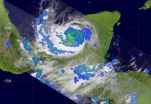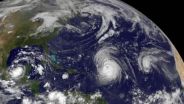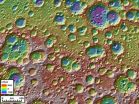UCSB, Texas A&M scientists document fate of deep hydrocarbon plumes in Gulf oil spill
2010-09-16
(Press-News.org) SANTA BARBARA, Calif., Sept. 16, 2010 — In the aftermath of the Deepwater Horizon disaster in the Gulf of Mexico, a team of scientists led by UC Santa Barbara's David Valentine and Texas A&M University's John Kessler embarked on a research cruise with an urgent mission: determining the fate and impact of hydrocarbon gases escaping from a deep-water oil spill.
The spill provided a rare opportunity for Valentine, a professor in the Department of Earth Science at UCSB, and Kessler, an assistant professor in the Department of Oceanography at Texas A&M, to study the behavior of methane and other natural gases in the murky depths of the Gulf of Mexico. The results of their research are published in a new paper, "Propane respiration jump-starts microbial response to a deep oil spill," published today (Sept. 16) as an advance online release in the journal Science.
"We were fortunate to have the expertise and opportunity to get to the heart of this national disaster and to contribute meaningfully to understanding what was happening in the deep ocean during the spill," Valentine, the lead author, said. "As a scholar, it is rare that your intellectual domain comes so abruptly to the forefront of the national consciousness. Circumstances aside, I feel that it reflects well on our country's scientific and educational systems that we foster such expertise."
The scientists conducted their tests June 11-21, less than two months after the Deepwater Horizon platform exploded, causing the largest marine oil spill in history. Their team conducted its experiments as close as 1,500 feet from the epicenter of the active spill, using underwater sampling devices and sensors to measure hydrocarbons and oxygen depletion at various depths, and to collect water samples to study the biodegradation of natural gas and the associated blooms of bacteria.
Their research was funded by the National Science Foundation and the Department of Energy, and was conducted on the Research Vessel Cape Hatteras.
The team reported several new findings in their study. At the time they sampled in June, they identified four large plumes of suspended hydrocarbons that had been moved by deep currents in different directions from the leaking well. Since each plume originated from the well at a different time, the scientists were able to compare the chemicals and isotopes to determine what compounds were preferentially respired by the bacteria.
What they found was surprising: Three specific hydrocarbon gases — ethane, propane and butane — were responsible for most of the respiration and oxygen loss observed in the deep plumes. They further identified the dominant bacteria present in the plumes and suggested some of the organisms were targeting the natural gases.
The team also found that methane gas, the single most abundant compound spilled by Deepwater Horizon, was initially consumed very slowly, but that the rate increased as other gases were depleted. They estimate that ultimately two-thirds of the bacterial productivity and respiration in the deep-water plumes will be linked to natural gas.
"Because the Deepwater Horizon rig accident occurred almost a mile deep, the slow migration of petroleum from that depth allowed time for dissolution of volatile hydrocarbons such as methane, ethane, propane, and butane," Valentine said. "Had it occurred in shallower water, these gases would have certainly escaped into the atmosphere. This gas trapping will go down as one of the distinguishing hallmarks of a deep oil spill."
Kessler added: "Dissolving these gases in the ocean is a bit of a double-edged sword. On the one hand, these gases influenced both the air quality and the radiative budget of the atmosphere, so trapping them within the ocean is a good thing. But their eventual marine biodegradation leads to the consumption of dissolved oxygen, which is an annual problem in the northern Gulf of Mexico. Fingerprinting the main chemicals responsible for the majority of the oxygen reductions associated with this spill is extremely helpful as we decide how to deal with this and other such events."
The scientists found that propane and ethane were the primary foodstuffs for microbial respiration, accounting for up to 70 percent of the observed oxygen depletion in fresh plumes. They further suggest that butane accounts for much of the remainder. They learned that the ratio of methane to ethane and propane varied substantially throughout the deep plumes and served as the indicator of bacterial activity.
The scientists concluded that deep oil and gas spills elicit a distinctive microbial response because of the trapped gases. They also suggest that bacterial blooms may turn their attention to oil after the gas is depleted as many bacteria can cross over with their metabolism. However, they caution that the metabolism of these bugs has not been established and that the specific bacteria that bloomed may only target specific compounds in oil.
While the results of this study suggest that ethane, propane and butane plumes may disappear quickly, methane may not, due to its relatively slow consumption rate. This suggests the potential for a much longer-lived methane plume in the deep ocean, with unknown consequences. To address this issue, Valentine and Kessler are currently leading another expedition supported by the National Oceanic and Atmospheric Administration in an attempt to determine the longer-term fate of methane and oil in the deep Gulf waters.
INFORMATION:
Joining Valentine on this research from UCSB were Molly Redmond, Stephanie Mendes, Monica Heintz, Christopher Farwell, Franklin Kinnaman and Christine Villanueva. Other Texas A&M researchers included Lei Hu, Shari Yvon-Lewis, Mengran Du, Eric Chan and Fenix Garcia Tigreros.
(Note to editors: For more information, contact David Valentine by e-mail at valentine@geol.ucsb.edu. For downloadable images from the research cruise, go to http://www.ia.ucsb.edu/pa/display.aspx?pkey=2321)
About research at Texas A&M University: As one of the world's leading research institutions, Texas A&M is in the vanguard in making significant contributions to the storehouse of knowledge, including that of science and technology. Research conducted at Texas A&M represents an annual investment of more than $582 million, which ranks third nationally for universities without a medical school, and underwrites approximately 3,500 sponsored projects. That research creates new knowledge that provides basic, fundamental and applied contributions resulting in many cases in economic benefits to the state, nation and world.
ELSE PRESS RELEASES FROM THIS DATE:
2010-09-16
La Jolla, CA, September 15, 2010 – Scientists at The Scripps Research Institute have designed a new molecular test that will allow researchers to look for potential drugs targeting a human metabolic enzyme believed to stimulate the appetite and play a role in diabetes.
The new test, which the scientists call a simple assay, will allow researchers to look through hundreds of thousands of compounds for those that have potential to block the action of an enzyme known as ghrelin O-acyltransferase (GOAT). If drugs can be found that safely suppress the action of GOAT, they ...
2010-09-16
PITTSBURGH, Sept. 15 – Fat-derived stem cells can be safely used to aid reconstruction of breast tissue after mastectomy as long as there is no evidence of active cancer, according to researchers at the University of Pittsburgh School of Medicine. Their findings are available in Tissue Engineering Part A.
Plastic surgeons have long moved fat from one part of the body into the breasts for reconstruction, but with some complications and a varying success rate, explained senior author Vera S. Donnenberg, Ph.D., assistant professor of surgery, Pitt School of Medicine. More ...
2010-09-16
Significant weight loss not only improves daily life of morbidly obese woman but also decreases the risk for cardiovascular disease (CVD). However, many people can not lose weight or can not maintain weight loss without help. Bariatric surgery is emerging as a valuable procedure to help morbidly obese individuals lose weight, as studies have shown; it can improve many health profiles and lower mortality. Now, researchers have found another positive impact of significant weight loss after bariatric surgery: it can significantly improve the lipoprotein profiles of women within ...
2010-09-16
NASA's Aqua and TRMM satellites have been watching Karl's clouds and rainfall as he moved across Mexico's Yucatan Peninsula and into the Gulf of Mexico today, powering up into a hurricane.
Infrared imagery of Karl's cloud temperatures from NASA's Atmospheric Infrared Sounder (AIRS) instrument this morning, Sept. 16 at 0753 UTC (3:53 a.m. EDT) showed strong convective activity in his center as indicated by high thunderstorms that were as cold as -63 Fahrenheit. That strong convection was an indication that the warm waters of the Gulf of Mexico were strengthening the storm. ...
2010-09-16
CORVALLIS, Ore. – A new study by an Oregon State University business professor has found that developing countries that adopt major international economic treaties do not necessarily gain more foreign direct investment.
In fact, in some cases adopting these treaties can hurt, not help a developing country, contrary to what agencies such as the World Trade Organization (WTO) espouse. The study, published in the current online version of the Journal of World Business, has major implications for Latin American and Caribbean intellectual policy reform
Ted Khoury, an assistant ...
2010-09-16
GOES-13 satellite imagery this morning showed the "tropical trio": Tropical Storm Karl over the Gulf of Mexico, Hurricane Igor in the central Atlantic, and a waning Hurricane Julia in the eastern Atlantic Ocean. Hurricane Julia has now lost her Category 4 Hurricane status, and is currently a Category 2 hurricane in the eastern Atlantic and weakening. Wind shear, cooler sea surface temperatures and warmer cloud top temperatures all spell a weaker Julia.
The Geostationary Operational Environmental Satellite known as GOES-13 that monitors weather over the U.S. East Coast ...
2010-09-16
ANN ARBOR, Mich.---As another round of talks continues between Israelis and Palestinians, a new University of Michigan study documents the impact the violence has been inflicting on the region's children.
Palestinian and Israeli children not only suffer the direct physical consequences of violence, they are also being psychologically scarred by the high levels of violence they witness, according to the study, presented earlier this summer at the International Society for Research on Aggression.
Nearly 50 percent of Palestinian children between the ages of 11 and 14 ...
2010-09-16
The moon was bombarded by two distinct populations of asteroids or comets in its youth, and its surface is more complex than previously thought, according to new results from NASA's Lunar Reconnaissance Orbiter (LRO) spacecraft featured in three papers appearing in the Sept. 17 issue of Science.
In the first paper, lead author James Head of Brown University in Providence, R.I., describes results obtained from a detailed global topographic map of the moon created using LRO's Lunar Orbiter Laser Altimeter (LOLA). "Our new LRO LOLA dataset shows that the older highland impactor ...
2010-09-16
A multinational team that includes a North Carolina State University researcher has found another piece of the atmospheric puzzle surrounding the effects of aerosol particles on climate change. Their findings will contribute to our ability to more accurately measure human impact on climate, and to determine how much pollution may "mask" the actual rate of climate change.
Dr. Markus Petters, an NC State assistant professor of marine, earth and atmospheric sciences, traveled to the Amazon rainforest in a remote area of Brazil as part of a team that wanted to study how a ...
2010-09-16
ANN ARBOR, Mich. — A University of Michigan-led research team has identified a gene responsible in some families for a devastating inherited kidney disorder, thanks to a new, faster method of genetic analysis not available even two years ago. The success offers hope that scientists can speed the painstaking search for the genes responsible for many rare diseases and test drugs to treat them.
The U-M scientists report their success with exome capture, a groundbreaking genetic analysis technique, in the September issue of Nature Genetics.
The U-M- led international ...
LAST 30 PRESS RELEASES:
[Press-News.org] UCSB, Texas A&M scientists document fate of deep hydrocarbon plumes in Gulf oil spill


